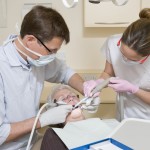
Although dental caries is the world’s commonest disease improvements in oral health have led to increased retention of teeth. As a result of broader improvements in health there has also been an increase in life expectancy in many areas of the world. These trends mean that there is also an increase in the number of teeth at risk of both caries and root caries in older adults. Consequently, identifying the best preventive approaches for this group is increasingly important.
The aim of this trial was to compare the effectiveness of 5000ppm fluoride toothpaste with conventional ( 1450ppm) fluoride toothpaste for the prevention and arresting of root caries.
Methods
Independently-living older adults (aged 60 and above) with at least one tooth with a root canal lesion (RCL) were randomised to either high-fluoride (5,000 ppm F) or the control toothpaste (1,450 ppm F). Participants were instructed to brush for two minutes twice per day and spit not rinse after brushing. The primary outcomes were the incidence and activity of lesions of RCLs per root at 2 years. Clinical examinations were conducted by a single calibrated examiner. Linear mixed regression model with repeated measures were used to test differences between groups.
Results
- 345 patients, 258 (74%) females and 87 (26%) male were randomised.
- Age range 61 – 88 year (mean 69.63 ± 6.25).
- 65 patients (34 from control, 31 from intervention) were lost to follow up at 2 years.
- At the final examination a total of 2,628 teeth with RCLs were identified in 280 participants.
- 1440 teeth with RCLs were detected in the control compared with 1,188 in the intervention group.
| 5000ppm | 1450ppm | |
| No. of patients | 142 | 138 |
| Teeth with RCLs at baseline | 1163 | 952 |
| Teeth with RCLs at 2 years | 1188 | 1440 |
- In the control group there was an increase in the number of teeth with active RCLs (from 589 to 915) and inactive RCLs (from 363 to 525). While the interventions demonstrated an increase in the inactive RCLs from the baseline data (from 359 to 1,094) there was a marked decrease in the number of total teeth with active RCLs (from 804 to 94).
- 93.5% of patients in the control developed new RCLs compared to 35.2% in the 5000ppm group. RR= 0.1 (95%CI; 0.05- 0.19)
Conclusions
The authors concluded: –
Self-administered non-invasive therapy with high-F dentifrices appears to be highly effective in arresting active RCLs and in reducing the onset of new lesions in community-dwelling elders. Treatment with a 5,000 ppm F- dentifrice appears to be an attractive alternative to traditional restorative treatment for older adults, allowing expanded access to care, at a much lower cost and suitable for non-clinical settings.
Comments
To date only a handful of RCTs have been conducted on preventive approaches to root caries in older adults as the vast majority of caries prevention trials to date have been children and adolescents. This RCT was registered at Clinicaltrials.gov and compared 1450ppm and 5000ppm for the arrest and prevention of RCLs. Recruitment to the trial was greater than the estimate of 152 per arm with drop-out being slightly below the anticipated 20% level. Despite the computer randomisation procedure, the authors noted an imbalance in the baseline with patients allocated to the 5,000 ppm group having a higher number of RCLs than the control group. However, a much lower proportion of patients in the 5,000 ppm group developed new RCLs (35.2%) compared with the 1450ppm group (93.5%). This results in a NNT (Number Needed to Treat) of 1.71 mean that just two patients would need to be treated with high fluoride toothpaste to avoid one new RCL suggesting an effective intervention.
While this paper reports on the outcomes regarding root canal lesions there is no information on adverse effects or whether data was collected. In addition, some of the secondary outcome measures outlined in the initial trial registration, Oral Health Related Quality of Life, microbiological outcomes and salivary flow and not reported in this paper.
Links
Primary Paper
León S, González K, Hugo FN, Gambetta-Tessini K, Giacaman RA. High fluoride dentifrice for preventing and arresting root caries in community-dwelling older adults: A randomized controlled clinical trial. J Dent. 2019 Jul;86:110-117. doi:10.1016/j.jdent.2019.06.002. Epub 2019 Jun 6. PubMed PMID: 31176788.
Other references
Dental Elf – 22nd Aug 2018
Dental Elf – 23rd Aug 2017
Dental Elf – 19th Nov 2014
